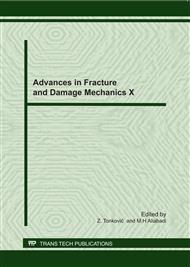p.45
p.49
p.53
p.57
p.61
p.65
p.69
p.77
p.81
Corrosion Inhibition of Stress Corrosion Cracking and Localized Corrosion of Turbo-Expander and Steam/Gas Turbines Materials
Abstract:
Stress corrosion cracking of 7050 aluminum alloys and ASTM A470 steel in the turbo expander and steam/gas turbine industry can cause expensive catastrophic failures, especially for turbo machinery systems performing in hostile, corrosive environments. Commercially available inhibitors were investigated for their effectiveness in reducing and controlling the corrosion susceptibility. Inhibitor effectiveness was confirmed with electrochemical corrosion techniques in different solutions. Polarization resistance increased with concentration of corrosion inhibitor due to film formation and displacement of water molecules. Cyclic polarization behavior for samples in the 1.0% and 5.0% inhibitors showed a shift in the passive film breakdown potential. The substantial increase in the passive range has positive consequences for neutralizing pitting and crevice corrosion cell chemistry. The strain to failure and tensile strength obtained from the slow strain rate studies for both alloys showed pronounced improvement due to corrosion inhibitor ability to mitigate SCC; the fractographic analysis showed a changed morphology with ductile overload as the primary failure mode instead of transgranular or intergranular cracking.
Info:
Periodical:
Pages:
61-64
Citation:
Online since:
September 2011
Authors:
Price:
Сopyright:
© 2012 Trans Tech Publications Ltd. All Rights Reserved
Share:
Citation:


